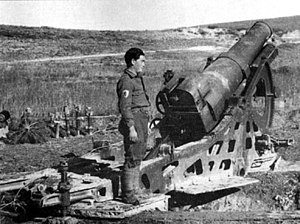Umitaka-class submarine chaser
 JDS Umitaka | |
| Class overview | |
|---|---|
| Name | Umitaka class |
| Builders | |
| Operators | |
| Preceded by | Hayabusa class |
| Succeeded by | Mizutori class |
| Built | 1959-1963 |
| In commission | 1959-1989 |
| Planned | 4 |
| Completed | 4 |
| Retired | 4 |
| General characteristics | |
| Type | Submarine chaser |
| Displacement | |
| Length | 60.5 m (198 ft 6 in) |
| Beam | 7.1 m (23 ft 4 in) |
| Draft | 2.3 m (7 ft 7 in) |
| Depth | 4.4 m (14 ft 5 in) |
| Propulsion |
|
| Speed | 20 kn (37 km/h; 23 mph) |
| Complement | 80 |
| Sensors and processing systems | |
| Electronic warfare & decoys | |
| Armament |
|
The Umitaka-class submarine chaser was a class of submarine chasers of the Japan Maritime Self-Defense Force after the Second World War, in the late 1950s.
Design
In this type, the navigation performance was improved and the design was rationalized based on the operational results of the preceding 1954 planned boats (Kari-class, Kamome-class). The basic design was carried out by the Ship Design Association for boats in 1954, but it was transferred from this model to the Technical Research Institute of the Defense Agency (at that time), and the plan number was K103B.[1]
They were designed to be larger (1.4 times the standard displacement) based on the FY1954 plan, and the ship type was the same flush deck type. In the 1954 classes, the elaborate design with extremely thin plates led to an increase in man-hours, so the bow was 2.9 to 3.2 mm thick, but now it is 4.5 to 6 mm, and the area below the waterline is also 4.5 to 8 mm. Although it was thickened to millimeters, it still had a thin plate structure as a whole. In addition, in the 1954 classes, the bridge and the deck room were separated in order to reduce the area on the wind pressure side, but there were drawbacks such as the inconvenience of communication inside the ship in stormy weather and the inability to secure sufficient space inside the ship. Therefore, in this model, the front and rear superstructures are integrated so that it can be easily moved back and forth even in stormy weather.[2]
전투지역, 장교실 등 일부 지역에 에어컨을 도입하고 거실(1인당 면적 10% 증가)을 확대해 주거환경을 개선했다.그러나, 이러한 요인에 의해, 무게 중심이 상승해 안정성이 저하해, 우미타카와 오타카에는 약 15톤의 고정 밸러스트가 장착되었다.또한 다음 보트에 대해서는 상부 갑판 두께 변경(6mm에서 5mm)[2] 등 장비를 포함한 재점검을 통해 무게중심을 낮추는 조치를 순차적으로 취하였다.
다리의 날개와 더불어 최종 선박인 구마타카호만이 주력 설비를 갖추고 있었기 때문에 상부 구조물을 후방으로 2.5m 연장하여 본부 총무실을 제공하고 있다.또한 1934년 보트 이후 상부구조물의 측벽에 골판지 패널이 채택되어 공수와 무게를 [3][2]줄였다.
메인 엔진으로는 카모메급과 거의 같은 구성의 비교적 무거운 중속 견고한 디젤 엔진과 덴마크 B&W와 라이선스 계약을 맺고 미쓰이조센이 제조한 635VBU-45 타입 2가 채용되었다.트렁크-피스톤 디젤 엔진과 사이클 단동 인라인 6기통 배기 터보차저가 장착되었습니다.이카즈치급 이나즈마의 950VBU60형(출력 6000마력)의 절반의 실린더 출력을 전년도 계획에 짜넣은 자매 엔진으로 개발.자동 반전 메커니즘을 갖추고 있으며 추진 장치에 직접 연결됩니다.사용된 연료는 일반 디젤 [4]엔진용 중유 1번 A호였다.
장비.
음파탐지기로서, 25.5 kHz급 스캐닝 AN/SQS-11A는 1954년식과 마찬가지로 40 mm 트윈 보퍼스 포의 바닥에 설치되었다.한편, 레이더로서 1954년의 보트는, 미국제의 X밴드를 사용한 AN/SPS-5B를 탑재하고, 이 모델은 일본제의 OPS-16을 사용했습니다.또 이 기종 이후 전자전 지원용 전파검출기(ESM)가 설치돼 1957년 계획으로 건조된 첫 번째 2척(우미타카, 오타카)은 상부구조물의 후단에 직접 설치됐고 마지막 [3][2]2척은 기둥에 설치됐다.
고각 기관총 시스템은 1954년식 보트와 비슷했고, 전면 갑판에는 Mk.1 40mm 쌍발 기관총이 장착되었다.Mk.63 화재통제시스템(GFCS)에 의해 지휘되었고, 교량 상부에 국장이, 총 측면에 화재 레이더가 배치되었다.또 고슴도치 Mk.10 대잠 박격포를 교량 구조물 바로 앞에 배치하고 선미 양쪽에 54형 깊이 돌격 낙하 레일(1라인당 깊이 돌격 6개)을 설치했다.그러나 1954년식 보트는 후갑판에 배치된 55식 깊이돌격 프로젝터(일명 Y포) 대신 유도장치를 갖춘 대잠수함 쇼트어뢰가 채택됐다.초기 건조된 두 척은 직경 483mm의 Mk.32 짧은 어뢰를 발사하는 짧은 어뢰 프로젝터를 사용했고, 후기 건조된 두 척(와카타카와 쿠마타카)은 미국에서, 324척을 제작했다.지름 1mm의 Mk.32를 생산하는 68식 트리플 쇼트 어뢰 발사기로 바뀌었다.이는 후속 해상자위대 함정의 표준장비가 됐지만 이급과 미즈토리급 잠수함 추격기가 [2]처음 장착됐다.
급선박
| 우미타카급 수리 잠수함 체이서 | |||||||
|---|---|---|---|---|---|---|---|
| 페넌트 번호 | 이름. | 빌더 | 누웠다 | 개시. | 위탁. | 재지정 | 폐지되었다 |
| PC-309 / ASU-86 | 우미타카 | 가와사키 중공업 | 1959년 5월 13일 | 1959년 7월 25일 | 1959년 11월 30일 | 1980년 3월 17일 | 1984년 3월 10일 |
| PC-310 / ASU-88 | 오타카 | 쿠레 해군 병기 | 1959년 3월 18일 | 1959년 9월 3일 | 1960년 1월 14일 | 1981년 3월 27일 | 1985년 3월 5일 |
| PC-317/ASU-64 | 와카타카 | 1962년 3월 5일 | 1962년 11월 13일 | 1963년 3월 30일 | 1985년 3월 27일 | 1988년 3월 17일 | |
| PC-318 / ASU-65 | 구마타카 | 후지나가타 조선소 | 1963년 3월 20일 | 1963년 10월 20일 | 1964년 3월 25일 | 1989년 3월 27일 | |


